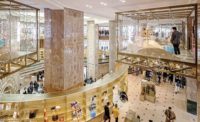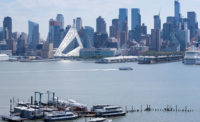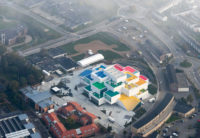Chef René Redzepi’s interpretation of Nordic cuisine contains a few surprises—live ants being among the more startling ingredients on the legendary Noma’s tasting menu, which starts at around $350—but this has not deterred customers. Since he opened his experimental restaurant in a Copenhagen waterfront warehouse in 2003, it has been repeatedly lauded as one of the world’s best.
Additional Content:
Jump to credits & specifications
While the original Noma closed in 2017, its success gave co-owner Redzepi the chance to build his dream restaurant from the ground up. He envisioned a modest agricultural commune in a bucolic but urban setting, a cluster of small farm-style buildings in which he would serve a cuisine parceled into three seasonal segments: seafood in the winter and spring, vegetarian for summer, game and forest in the autumn. So, when the opportunity arose, Redzepi snatched up a lakefront site near the city’s Christiania neighborhood. Then he signed on the architect Bjarke Ingels, with whom he had been discussing a potential project.
Employing oak, brick, steel, concrete, and tombac—a brass alloy with high copper content—Ingels, founder and creative director of BIG-Bjarke Ingels Group, devised a 14,000-square-foot “village” comprising 11 one-story pavilions that correspond to the client’s vision. Three are greenhouses—one serving that purpose, another a bakery, and the third a test kitchen. The remaining eight—including a renovated existing concrete warehouse that once stored explosives for the Danish navy—are occupied by the restaurant, integrated and connected by glass-covered walkways. “You see sun,” says Ingels. “The roofs get covered with snow, and on rainy evenings, you know certain things might be foraged the next morning.”
The architects divided the restaurant’s programs among these structures, imparting a unique identity to each through a rich variety of building materials: the entrance is wood, partially clad with tombac; a lounge built with two shades of brick; the main dining room, and one for private dinners, both wood; a dark-concrete storage building for the wait staff’s equipment; a barbecue station in weathering steel; and the existing building, which houses refrigeration, a fermentation lab, prep kitchen, a staff canteen, and changing room. These are all grouped around the 600-square-foot service kitchen, Noma’s pulsating heart. This way, says Ingels, “cooks can see a table is about to finish.” Also, people come here to experience the cooking process. That doesn’t include its smoke, steam, and heat, however. The entire blackened-steel roof of the service kitchen contains a powerful ventilation system.
To create a comfortable atmosphere, Redzepi turned to an interior designer he had admired on Instagram, the Copenhagen-based Studio David Thulstrup. “They were looking for something that felt homey,” recalls Thulstrup, which he responded to with spare, concise layering, using mostly custom furniture and subtle, nature-inspired art.
Within the entrance, the architects applied untreated oak to the ceiling and walls. Collaborating with the BIG design team, Thulstrup set river stones into a sandblasted concrete floor—to allow bare feet, if desired, to feel “the texture, which is like walking on a little riverbed,” he says. Redzepi also commissioned Icelandic-Danish artist and friend Olafur Eliasson to create an installation for this space. The ceiling-mounted driftwood-and-rare-earth-magnet sculpture, named Conscious Compass, flies due north. The only other furnishings here are a roughly cast ceramic vase by Frederik Nystrup-Larsen and Oliver Sundqvist, propped on a rugged piece of reclaimed wood, and a lone seat, one of the dining chairs designed by Thulstrup, with slightly elevated woven-cord seats to encourage diners to lean toward the table.
Wanting to maintain a “bright environment” in the 680-square-foot lounge adjacent to the entrance, the design team clad its ceiling with oiled oak. Thulstrup selected a buttery-hued brick for the walls and open fireplace, several shades lighter than the brick BIG used on the building’s facade. This genial area, illuminated with conical Oregon pine pendants by Jorgen Wolff and furnished with a mix of new and vintage Danish classics, references a 1970s home and offers views of the lake.
The fermentation and research incorporated into Redzepi’s cooking are evident in the foyer outside the lounge just beyond the entrance, where an arrangement of glass laboratory jars on a custom oak table contains such changing seasonal “treasures” as a preserved octopus floating in amber embalming fluid. Sea life brims in one large aquarium; in another, burrowing ants. Nearby, mechanical thumps and whirs of high-tech machinery emerge from the fermentation lab. The ultrahomogenizer, says research-and-development sous chef David Zilber, “sounds like a dying hellcat.”
The service kitchen reveals the staff at work around oak-clad islands conceived to withstand the wear and tear of daily use. “Some parts are veneer or metal, with no wood joinery—which would break—and some are solid wood, which won’t crack if you oil it,” Thulstrup says.
The main and private dining areas, in oak and Douglas fir respectively, offer an entirely different type of comfort, with pitched roofs that add a barn-like feel. Scandinavian craft is apparent everywhere. The skylit 1,300-square-foot main dining room features stacked-oak walls, joined by 250,000 invisible screws, in stark contrast to the naturally blackened pine beams used to fabricate a service credenza and also tall sculptural installations that jut out of the floor. The beams were found in a local harbor, says Thulstrup. “They were put in the water in preparation for making warships and then just forgotten.”
Artist Jonas Edvard’s ground-seaweed pendants hang above the 20-foot-long smoked-oak communal table that dominates the 660-square-foot private dining room, which also opens onto the kitchen. A rhythmic progression of canted wood beams overhead sets a playful mood. The beams align with columns along a window wall on one side of the room and with shelving on the opposite wall, where artifacts from the restaurant’s collection are showcased.
With such clearly stated simplicity, the result of a creative collaboration among the two design teams and the restaurateur, Noma’s fresh new digs (dubbed Noma 2.0 in-house) only serves to magnify the astonishing complexity of Redzepi’s dishes—think a minimalistic, nature-inspired stage for a rich broth of Faroese sea snails or teal for two.
CreditsArchitect: BIG-Bjarke Ingels Group Kløverbladsgade 56 2500 Valby, Copenhagen Denmark +45.7221.7227
Interior design: Studio David Thulstrup Lergravsvej 59, 1.tv., 2300 Copenhagen S Denmark
Personnel in architect's firm who should receive special credit: David Thulstrup, principal
Engineers: Helden ApS (electrical); LuVa Consulting (ventilation/water/plumbing); BIG Engineering (construction)
Consultants: Big Ideas (wind); Anker og Co (lighting); Sif-Gruppa (acoustics); Elgaard Architecture (listed-building advisor); Thing og Brandt Landskab (landscape architect); NT Consulting (site and project manager); Cowi Brand (fire prevention) |
SpecificationsInterior Finishes Special surfacing: Dinesen (Douglas Pine planks used for floor, ceiling and wall panels) Floor and wall tile: Peter Bendtsen custom terrazzo floor using river stones); Petersen Tegl (custom bricks) Rugs: Kasthall
Furnishings Kitchen: Maes Inox (oak-clad kitchen islands designed by Studio David Thulstrup); Malte Gormsen (custom cabinets, credenza) Seating: Tärnsjo (leather bench near the entrance); Nikari (December XL chairs); Brdr. Krüger (custom Arv dining chair designed by Studio David Thulstrup); Nikari (lounge chairs). Tables: Brdr. Krüger; Malte Gormsen Textiles/Leather: Astrid (draperies); Sørensen Leather, Tarnsjö (leather cushions); Kvadrat, Pierre Frey, Ragnhild Ragnasdottir (upholstery); Ragnhild Højgaard (cushions); Audrey Louise Reynolds (throws)
Lighting Interior ambient lighting: Anker & Co. (wall outdoor-style sconce); Jonas Edvard (custom pendant lampshades); Wasterberg Downlights: XAL Tasklighting: XAL Exterior: Techna + Castaldi
Art & Craft “Conscious Compass”, 2018, Olafur Eliasson “Mater” vase (at entrance) by Frederik Nystrup-Larsen and Oliver Sundqvist Crushed Stone wall art by Carl Emil Jacobsen
Plumbing Kitchen fittings: Dornbracht
|
























Post a comment to this article
Report Abusive Comment